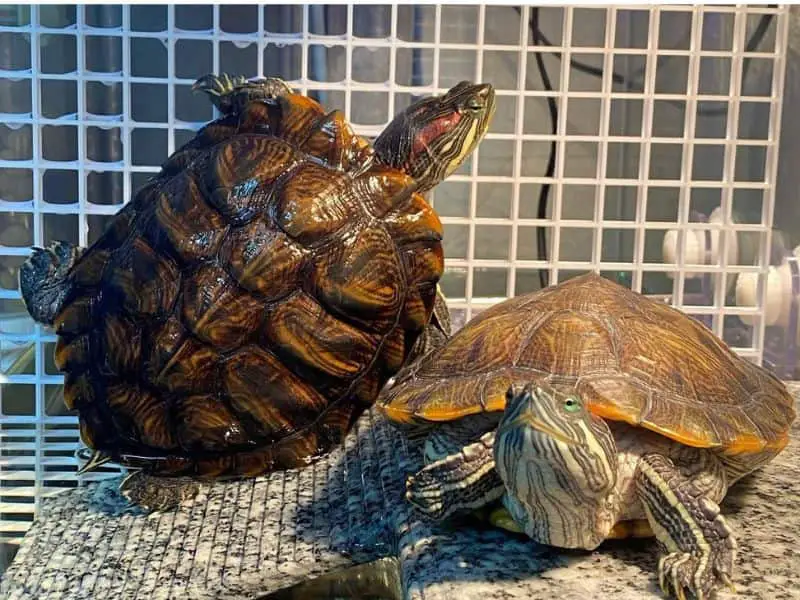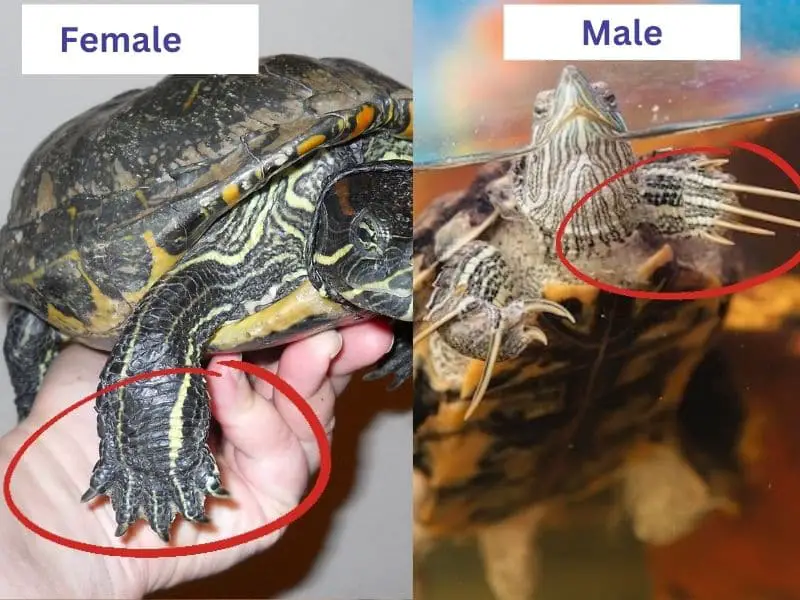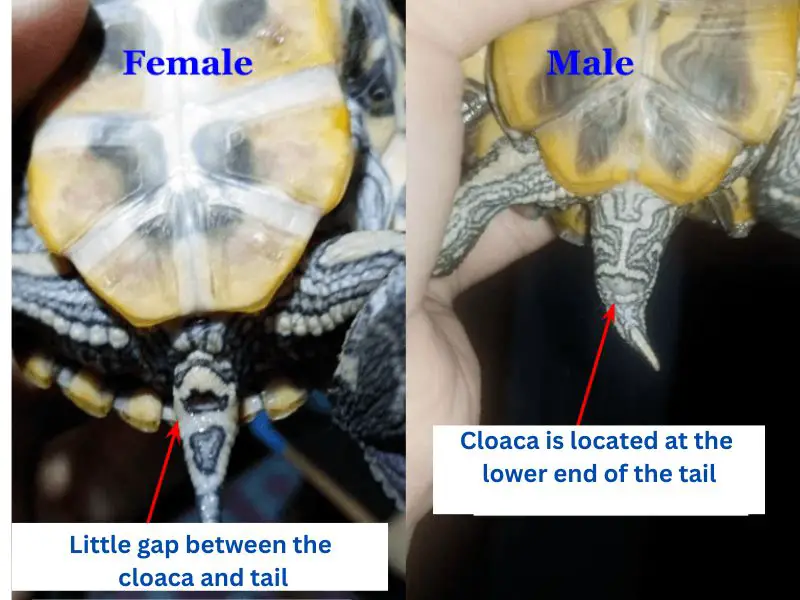Telling the difference between a male and female red-eared slider is essential if you want to name or breed the turtles. Or maybe you are curious and want to know your red-eared slider’s sex. Although telling the gender of hatched red-eared sliders can be challenging, it is much easier with juveniles and adult red-eared sliders.
You can tell the gender of a red-eared hatchling by recording the temperatures in which the turtle incubated them. A temperature below 81.86°F results in male red-eared sliders, and above 88.8°F will make them female. However, red-eared sliders show visible sexual dimorphism beyond two years. That is when the females start getting larger than the males.
You can also determine the gender of your red-eared sliders by examining their front claws, tail size, coloration, and the shape of the plastron. Most importantly, examine the position of the cloaca (the opening they use for urination, excretion, and respiration). I have discussed in this article how to tell if your red-eared slider is a male or female. Learn more below.
How do you tell if a red-eared slider is male or female?

Here are some ways to determine the gender of your red-eared slider:
1. Size & Age
Size is the best way to tell the difference between a male and female red-eared slider, but it is not foolproof because it works with adult turtles only. Red-eared slider hatchlings look alike and are difficult to distinguish.
You should notice the size difference if your red-eared slider is over two years old. In that case, the females will appear larger than the males. In adulthood, the female sliders can be 4-inches larger than the males.
The males will reach about 5 to 9 inches, while the female slider can grow up to 12 or 13 inches. That means that the female red-eared sliders also weigh slightly more than the males.
Male red-eared sliders will reach only 4 pounds while the females will weigh up to 7 pounds.
2. Shell
Unlike the red-eared slider shape and size, you can tell a male from a female by examining the turtle’s shell. You may not see the shell differences during the first two years of the slider’s life.
Use this strategy if your red-eared sliders are sexually mature. That is when they are between three and five years old. During this period, the male’s plastron (belly shell) curves slightly inwards concavely.
On the other hand, the female red-eared slider’s plastron will remain flat or protrude outwards. The male slider’s concave plastron is an adaptation for fitting on top of the female during mating.
Touch the underbelly of your sliders carefully without tilting the turtle. If it is flat, that is a female red-eared slider. Their plastrons are flat to provide enough internal space for storing eggs. Otherwise, a concave plastron suggests that it’s a male red-eared slider.
3. Claw length

Young red-eared sliders have the same claw length. But as the turtles grow older, the female’s claws will reach only about 0.8cm. Note that the claw length in female sliders is the same for its front and hind legs. However, the female slider’s hind claws are slightly longer than the front claws to dig sand when laying eggs.
On the contrary, the front claws of male red-eared sliders are longer than the rear claws. On average, the male’s long claws will reach 1.52cm. The claws are an evolutionary mechanism for attracting females and having a firm grip during intercourse.
However, poor nutrition and a poorly maintained pond may impact the claw size. Therefore, it might be challenging to ascertain the sex of your turtles using their claw length if your pond conditions and feeding program are inadequate.
4. Tail

Another more straightforward way to sex red-eared sliders is by examining their tails. This criterion can be practical even when the turtles are as young as one year old.
The red-eared slider with a long and thick tail is a male. The one with a short and skinny tail is a female.
On the other hand, females have short tails to make laying eggs much more effortless. Besides, the female’s reproductive organs are located far inside the shell and not outwards.
5. Coloration & Markings
Red-eared sliders have red or maroon stripes behind each eye. Their plastron occurs in yellow patterns, and the carapace could be olive or dark brown. However, male red-eared sliders do not maintain the same color throughout their lives.
Those who have reared red-eared sliders for a long time will tell you that the males turn color as they age. If your slider was born with contrasting colors, but you can notice the hues darken over time, he is probably a male turtle.
However, if your red-eared slider has not changed its skin color or pattern in a long time, it is a female turtle. The males have more melanin than the females. As such, the former will darken as they age and may even turn black entirely.
6. Position of the Cloaca

As I explained earlier, the cloaca is the opening red-eared sliders use to urinate, excrete, and reproduce. Remember that the male red-eared slider’s tail is longer and much thicker, right? Therefore, you can see its cloaca towards the lower end of the tail.
Besides, the distance between the male slider’s tail and the cloaca is wider. However, there is little to no gap between the female red-eared slider’s tail and cloaca.
Below is a summary of the differences between male and female red-eared sliders:
| Characteristic | Male red-eared slider | Female red-eared slider |
| Size | 5 to 9 inches4 pounds | 12-13 inches7 pounds |
| Shell | Concave plastron | Flat or protruding plastron |
| Claw length | 1.53 cm | 0.8 cm |
| Tail | Long and thick | Short and skinny |
| Coloration & Markings | Colors darken as they age | No color change from babyhood to adulthood |
| Position of the Cloaca | lower end of the tail. | no gap between tail and cloaca. |
How to tell if a baby red-eared slider is male or female
There are two easy ways to know if a baby red-eared slider is male or female. The simplest way is when the babies are at least one year old. During that time, examine their tails, as I discussed above.
First, if the baby-red-eared slider’s tail is thick and long, then it is a male. But if the tail is short and skinny, the baby turtle is female. However, the lack of sexual dimorphism at that age can make it difficult to tell them apart.
Therefore, the second way to know if your baby red-eared slider is male or female is by recording the temperatures at which the mothers incubated their eggs. A temperature below 81.86°F will result in male red-eared sliders, and above 88.8°F will make them female.
How old does a red-eared slider need to be to tell the gender?
Wait until your red-eared sliders are five years or older before determining their gender. The differences are more discernible at that age than when the turtles are younger.
For example, the male plastron will have curved, their claws will be longer, and they will be much darker than the females.
If you don’t know your turtle’s age, tell its gender when it is about 7 inches long.
Why you should know the gender of your red-eared slider
Here are some reasons why knowing your slider’s gender is essential:
- You want to name your turtle: Give a female red-eared slider a female name and give the male slider a male name.
- Breeding: If you don’t want to breed the turtles, you’d need to isolate the female sliders from the males.
- Habitat setup: The gender of the turtles determines how much space to give them in the pond. For example, the territorial males need more space than the female sliders.
- Diet: Knowing their gender allows you to choose the right food for their reproductive needs.
Is it better to have a male or female red-eared slider?
It is better to keep male red-eared sliders only because they will not lay eggs and add to the cost of turtle food and maintenance.
Can You Keep Male and Female Red-Eared Sliders Together?
I recommend keeping male and female red-eared sliders in the ratio of 1:2 to reduce competition for mates. It also allows the female sliders time to recuperate from the sexually active males.
However, you will need a minimum tank size of 100 gallons or more to keep male and female red-eared sliders together. In short, keep the turtles together if you want to breed them.
References
- Duke University. (2018). How Turning Down the Heat Makes a Baby Turtle Male. Research.
- Washington NatureMapping Program. (n.d). NatureMapping Animal Facts: Red-eared Slider. NatureMapping Foundation
